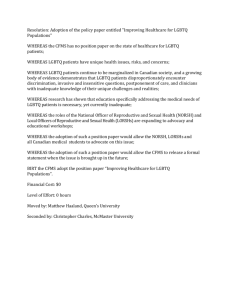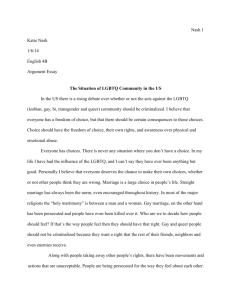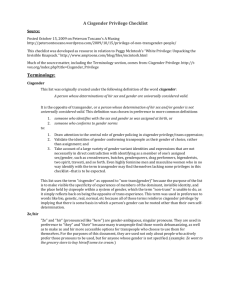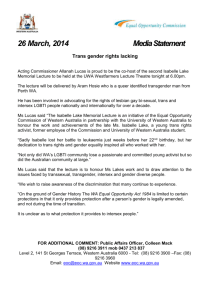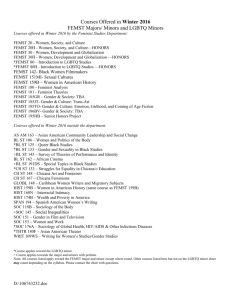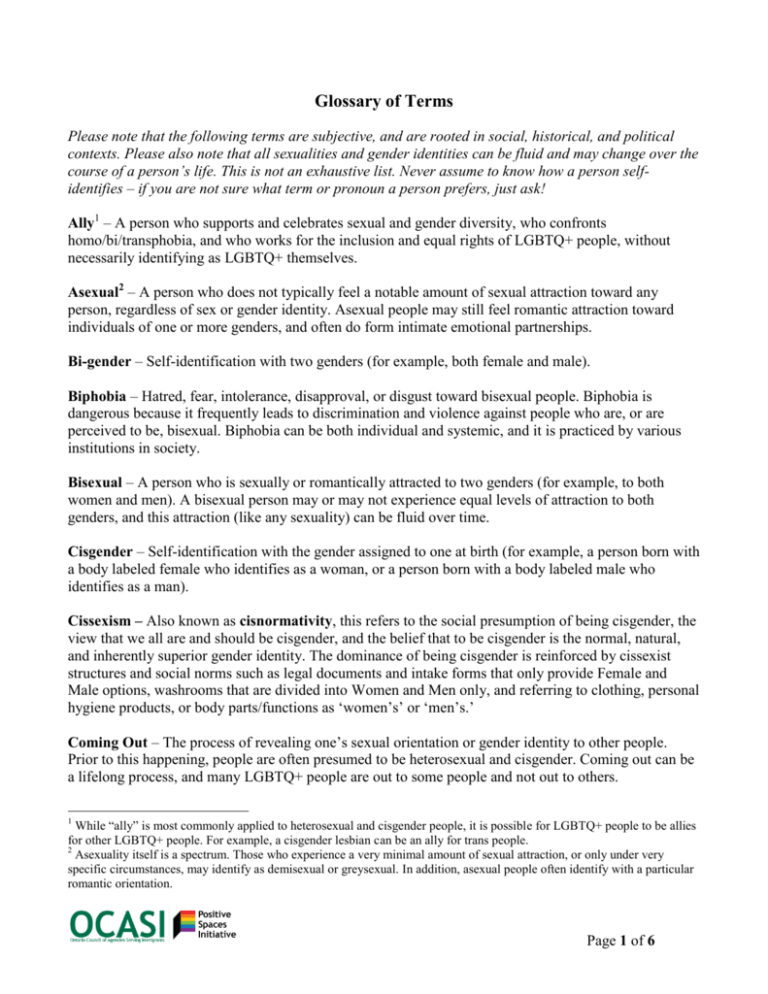
Glossary of Terms
Please note that the following terms are subjective, and are rooted in social, historical, and political
contexts. Please also note that all sexualities and gender identities can be fluid and may change over the
course of a person’s life. This is not an exhaustive list. Never assume to know how a person selfidentifies – if you are not sure what term or pronoun a person prefers, just ask!
Ally1 – A person who supports and celebrates sexual and gender diversity, who confronts
homo/bi/transphobia, and who works for the inclusion and equal rights of LGBTQ+ people, without
necessarily identifying as LGBTQ+ themselves.
Asexual2 – A person who does not typically feel a notable amount of sexual attraction toward any
person, regardless of sex or gender identity. Asexual people may still feel romantic attraction toward
individuals of one or more genders, and often do form intimate emotional partnerships.
Bi-gender – Self-identification with two genders (for example, both female and male).
Biphobia – Hatred, fear, intolerance, disapproval, or disgust toward bisexual people. Biphobia is
dangerous because it frequently leads to discrimination and violence against people who are, or are
perceived to be, bisexual. Biphobia can be both individual and systemic, and it is practiced by various
institutions in society.
Bisexual – A person who is sexually or romantically attracted to two genders (for example, to both
women and men). A bisexual person may or may not experience equal levels of attraction to both
genders, and this attraction (like any sexuality) can be fluid over time.
Cisgender – Self-identification with the gender assigned to one at birth (for example, a person born with
a body labeled female who identifies as a woman, or a person born with a body labeled male who
identifies as a man).
Cissexism – Also known as cisnormativity, this refers to the social presumption of being cisgender, the
view that we all are and should be cisgender, and the belief that to be cisgender is the normal, natural,
and inherently superior gender identity. The dominance of being cisgender is reinforced by cissexist
structures and social norms such as legal documents and intake forms that only provide Female and
Male options, washrooms that are divided into Women and Men only, and referring to clothing, personal
hygiene products, or body parts/functions as ‘women’s’ or ‘men’s.’
Coming Out – The process of revealing one’s sexual orientation or gender identity to other people.
Prior to this happening, people are often presumed to be heterosexual and cisgender. Coming out can be
a lifelong process, and many LGBTQ+ people are out to some people and not out to others.
1
While “ally” is most commonly applied to heterosexual and cisgender people, it is possible for LGBTQ+ people to be allies
for other LGBTQ+ people. For example, a cisgender lesbian can be an ally for trans people.
2
Asexuality itself is a spectrum. Those who experience a very minimal amount of sexual attraction, or only under very
specific circumstances, may identify as demisexual or greysexual. In addition, asexual people often identify with a particular
romantic orientation.
Page 1 of 6
Dominant Groups – The groups in a society with social power (for example, wealthy, white, Canadianborn, heterosexual, cisgender men without disabilities). The members of these groups experience
privilege based on group membership, including setting norms.
FTM (Female-to-Male) – A person who was born with a body labeled female, but who self-identifies
as male. Also known as a trans man or simply man. It is best to avoid the term FTM unless the person
you are speaking with has self-identified this way, as many people find this term invalidating and
offensive.
Gay – A male3 who is sexually or romantically attracted, either primarily or exclusively, to other males.
Other LGBTQ+ people, such as lesbians, may also self-identify as gay. Gay has historically been used
as an umbrella term for LGBTQ+ people in general.
Gender Binary – This refers to the concept that there are only two genders (male and female), and that
they are rigidly fixed categories which are inherently opposite of one another. Other examples of
binaries include black/white, night/day, and good/bad. A binary understanding of gender is problematic
because it denies the identities, experiences, and realities of people who do not fit neatly into either of
those boxes. Many people prefer to conceptualize gender as a spectrum, while other people reject the
entire concept of gender.
Gender Expression4 – How one conveys gender, typically through appearance, dress, mannerisms, etc.
Gender expression is read based on cultural norms, and varies in different places and contexts.
Gender-fluid – This refers to a person whose gender identity and/or expression is not fixed; rather, it is
fluid and flexible, and changes over short and/or long periods of time, and/or in different contexts and
situations. Many people experience gender fluidity to varying degrees; for some, gender-fluid is itself
their gender identity.
Gender Identity – One’s innate sense, understanding, and experience of one’s own gender, whether it
be femaleness, maleness, a mix of the two, or something else entirely. Gender identity does not
necessarily have anything to do with physical sex characteristics. Transgender, transsexual, bi-gender,
hijra, muxe, sworn virgin, third gender, and sometimes two-spirit are all terms related to gender identity.
Genderqueer – This is often used as an umbrella term for people whose gender identities are not
cisgender (for example, transgender, bi-gender, third gender, etc.). This is also a popular option for selfidentification because it exists outside of a binary understanding of maleness and femaleness, and its
meaning is not fixed or specific.
3
A male is any person who identifies as male, regardless of how society labels his body.
A person may choose to express the gender that matches their gender identity (which may not be what society expects based
on their assigned sex). Alternatively, a person may choose to convey a socially expected gender (especially in negative or
unsafe environments), and this may or may not reflect the gender that the person privately feels and identifies with.
4
Page 2 of 6
Heterosexism5 – Also known as heteronormativity, this refers to the social presumption of
heterosexuality, the view that we all are and should be heterosexual, and the belief that heterosexuality is
the natural, normal, and inherently superior pattern of loving. The dominance of heterosexuality is
reinforced by heterosexist social structures such as the institutionally-defined family, government, laws,
many religions, etc.
Heterosexual – A person who is romantically or sexually attracted, either primarily or exclusively, to
the so-called “opposite sex.” For example, a male who is attracted primarily or exclusively to females,
or a female who is attracted primarily or exclusively to males. Also known as “straight.”
Hijra6 – This term comes from South Asia (including India, Pakistan, and Bangladesh), where it is used
to describe a third gender category of people who were born with a body labeled male (or occasionally
intersex), but who have adopted appearance, dress, mannerisms, and roles more typically associated
with female gender. Hijras usually live together in separate communities, and sometimes perform
special ceremonial roles in society.
Homophobia – Hatred, fear, intolerance, disapproval, or disgust toward gays and lesbians. Homophobia
is dangerous because it frequently leads to discrimination and violence against people who are, or are
perceived to be, homosexual. Homophobia is frequently used as an umbrella term to include biphobia,
transphobia, and attitudes leading to the oppression of LGBTQ+ people in general. Homophobia can be
both individual and systemic, and it is practiced by various institutions in society.
Homosexual – A person who is sexually or romantically attracted, either primarily or exclusively, to
people of the same sex or gender identity. This includes gay men and lesbians.
Intersex7 – This is an umbrella term for a variety of conditions that a person can be born with, involving
a sexual or reproductive anatomy that society has trouble labeling as either definitively male or
definitively female. A person labeled with an intersex condition has a combination of sex characteristics
(for example external genitalia, internal reproductive organs, and/or chromosomes), some of which are
typically labelled as female, some of which are typically labelled as male, and/or some of which appear
to be somewhere in between. This was previously known as “hermaphrodite;” however, the term
“hermaphrodite” is considered offensive and should not be applied to humans.
5
This is the prevailing mode of thinking in mainstream Canadian society, as evidenced by the fact that heterosexual
cisgender people are the only ones who do not need to undergo a “coming out” process in order to have their true identities
recognized. Assuming that a man will have a female partner, or vice-versa, is also demonstrative of heterosexist thinking.
6
Hijras are only one example of many alternate gender categories that exist within various Asian cultures. Different terms
can have different meaning to different people as well. Do your research, and ask for clarification when working with people
from different cultures.
7
People labeled intersex are often subjected to non-consensual surgery as infants or young children so that their bodies can
be more easily labeled as either male or female. This invasive, coercive, and often emotionally damaging practice is rooted in
society’s lack of acceptance, not in the best interests of the person who has been labeled intersex. Infants and young children
should never be subjected to surgeries that are not medically necessary. If a person who is old enough to give informed
consent chooses to access any particular medical intervention, that is their right – many people labeled intersex do not wish to
access medical intervention, and it should never be forced on a person.
Page 3 of 6
Intersectionality8 – The concept of how multiple aspects of a person’s identity may be met with
multiple and intersecting forms of systematic oppression, while other aspects afford the same person a
certain amount of privilege and opportunity. This creates a complicated web of oppression and privilege,
and it can be very difficult to discern what exactly is happening and why. For example, a cisgender
Muslim lesbian immigrant without a disability may simultaneously face racism, xenophobia,
homophobia, Islamophobia, and sexism, but experience privilege not afforded to a trans person or a
person with a disability.
Lesbian – A female9 who is sexually or romantically attracted, either primarily or exclusively, to other
females.
LGBTQ+10 – This is an abbreviated acronym. L = Lesbian, G = Gay, B = Bisexual, T = Trans /
Transgender / Transsexual / Two-Spirit, Q = Queer / Questioning, + = Asexual / Intersex / Pansexual /
etc. The acronym is sometimes written in the longer form of “LGBTT2SIQQA” or similar.
Marginalization – The process of pushing groups with less social power to the margins of society.
MTF (Male-to-Female) – A person who was born with a body labeled male, but who self-identifies as
female. Also known as a trans woman or simply woman. It is best to avoid the term MTF unless the
person you are speaking with has self-identified this way, as many people find this term invalidating and
offensive.
Muxe – Emerging from the Zapotec culture in the Mexican state of Oaxaca, muxes (pronounced “MOOshays”) are people who are born with a body labeled male, but who live their lives as women and
generally present a female gender expression. The surrounding Zapotec community has traditionally
accepted muxes as a culturally-recognized third gender.
Non-Dominant Groups – The groups in a society with less social power (for example, people of colour,
Aboriginal people, newcomers, LGBTQ+ people, women, people with disabilities, etc.).
Out – See also coming out. As a noun, out refers to the state of being in which another person or people
are aware of one’s sexual or gender identity. Out can also be used as a verb, particularly when somebody
else reveals one’s sexual or gender identity to a third party without consent (i.e. “They outed me to my
parents!”). Never out somebody else, or assume that they are already out to a particular person or group.
8
Intersectionality is a very important concept when working with LGBTQ+ newcomers, as most will likely experience some
combination of racism, xenophobia, and homophobia / biphobia / transphobia, potentially in addition to other forms of
oppression such as sexism, ableism, classism, etc. The reality of intersectionality is one of the reasons why we need a unified
social justice movement, broadly inclusive networks, and integrated services.
9
A female is any person who identifies as female, regardless of how society labels her body.
10
There is no unanimous agreement on how to refer to the diverse communities that exist all along the spectrum of gender
and sexuality. Even the longer acronyms still do not include all identities (i.e. pansexual, genderqueer, hijra, muxe,
demisexual, greysexual, etc.), while the relatively shorter acronym of LGBTQ+ still manages to be cumbersome to say. Some
people use queer as an umbrella term, but this term can be offensive to some because of its pejorative history.
Page 4 of 6
Pansexual – A person who is sexually or romantically attracted to multiple genders. This is similar to
bisexual, but with the recognition of more than two genders, and the potential to feel attraction toward
three or more genders.
Passing – A term used in LGBTQ+ communities. Passing as straight, or passing as the gender one
identifies with, means that other people cannot tell that you are LGBTQ+. Passing depends on how one
is “read” by others, and it is required by a homo/bi/transphobic culture. The more that one is able to
pass, the safer one is in situations and places that are not LGBTQ+ positive. On the other hand, passing
can also mean being invisible, which is not always desirable.
Privilege – Benefits or special freedoms that are not necessarily earned and can occur unconsciously
because of social power. Dominant groups are taught not to see their privilege; it is something that they
typically take for granted. One example of heterosexual privilege is being able to hold hands with one’s
partner in public without risking harassment or violence.
Queer – Historically used as a pejorative term, queer has largely been reclaimed as an umbrella term or
self-identification by and for people with diverse sexual orientations and gender identities. It is a popular
option for self-identification because its meaning is not fixed or specific, thus one is not required to fit
one’s identity into a pre-determined box. Keep in mind that some people may still take offence to the
term, however, so use it with caution. As always, ask people how they self-identify and use whatever
term is preferred by the person in question.
Questioning – A state of questioning, exploring, or being unsure about one’s sexual orientation or
gender identity.
Sex – The label of female, male, intersex, or in transition. This label is typically assigned based on a
reading of a person’s sexual and reproductive anatomy. Sex may not be in any way related to a person’s
actual gender identity or gender expression.
Sexual Orientation – An innately-felt sexual or romantic attraction, either primarily or exclusively,
toward members of a particular sex or gender identity. Examples include gay, lesbian, bisexual,
heterosexual, pansexual, and asexual.
Sworn Virgin – This term comes from the Balkans, particularly northern Albania. A person born with a
body labeled female has traditionally had the option of swearing lifelong celibacy and henceforth living
as a man. The sworn virgin becomes a man in all aspects – appearance, dress, social and cultural roles,
legal rights (including inheritance in a patrilineal and patriarchal society), employment, and social
privilege. Sworn virgins are considered by some to occupy a third gender category in the cultures they
originate from.
Third Gender, Fourth Gender, etc. – Recognition of more than two genders, often contextualized
within a particular culture (for example, two-spirit people in many North American Indigenous cultures,
muxes among the Zapotec people of Mexico, hijras in South Asia, kathoeys in Thailand, sworn virgins
in the Balkans, etc.). Some people may choose to self-identify simply as third [or fourth, or fifth…]
gender.
Page 5 of 6
Trans – This is both an abbreviation (for transgender, transsexual, trans man, trans woman) and a standalone term for anyone who self-identifies with a gender other than the one assigned at birth. It is often
used as an umbrella term, while some people identify solely as trans.
Trans Man – A person who was born with a body labeled female, but who identifies as a man (see also
“FTM”). Trans men may self-identify simply as men.
Trans Woman – A person who was born with a body labeled male, but who identifies as a woman (see
also “MTF”). Trans women may self-identify simply as women.
Transgender – This is an umbrella term used to describe people who self-identify with a gender other
than the one assigned at birth. It can be used by people in any stage of transition (pre-operative,
undergoing hormone therapy, post-operative, and also those who may have no desire to ever undergo
medical transition).
Transition – The process that a trans / transgender / transsexual person may go through to bring their
gender expression (and sometimes their physical body, and sometimes their legal status) in line with
their gender identity. One’s transition may include coming out to increasingly more people, changing
how one dresses, adopting a new walk and mannerisms, developing a higher or lower voice, changing
one’s name, changing one’s sex designation on legal documents, changing one’s physical body through
medical interventions (including hormones and surgery), or all or none of these. The process of
transition is self-defined and varies widely from person to person.
Transphobia – Hatred, fear, intolerance, disapproval, or disgust toward trans people. Transphobia is
dangerous because it frequently leads to discrimination and violence against people who are, or are
perceived to be, trans. Transphobia can be both individual and systemic, and it is practiced by various
institutions in society.
Transsexual – A person who has committed to living full-time as a gender other than the one assigned
at birth, especially one who has undergone medical transition such as hormone therapy and sex
reassignment surgery11.
Two-Spirit12 – This is an umbrella term that seeks to encompass a wide variety of sexually and gender
diverse identity concepts from numerous North American Indigenous cultures and languages. The word
“two-spirit” is derived from the concept of having both a male and a female spirit. Many of the cultures
traditionally recognized the existence of a third gender, and/or conceptualized gender in a way that is
completely different from dominant Euro-North American society. In many Indigenous cultures, twospirit people have historically been valued and revered for their unique gifts, and have held special roles
in the community, including social, religious, and ceremonial duties.
11
Medical transition is not always accessible (due to structural transphobia); nor is it always desired by every transsexual
person.
12
Many sexually and gender diverse Indigenous people may choose to identify with a specific concept within their own
culture and language, rather than as two-spirit. Because two-spirit is both an umbrella term and a translation, it can lose much
or all of the cultural context inherent in more specific concepts. Please note that it is not appropriate to label a non-Indigenous
person as two-spirit – this would be cultural appropriation.
Page 6 of 6


